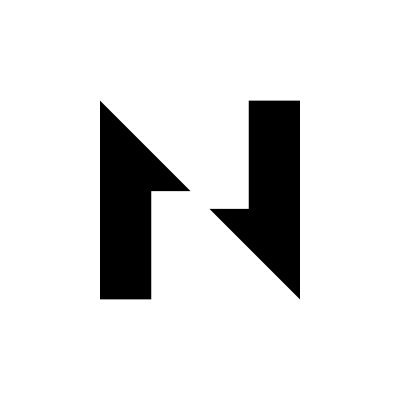Nervos Network (CKB): UTXO isomorphic BTC L2
Author: duoduo, Alfred, LD Capital
1. Brief Classification of BTC L2
The rise of BTC L2 is an undeniable narrative in this market cycle. BTC L2 includes at least two aspects: one is offchain, which is not on the BTC chain but has some association with it, such as joint mining related to consensus algorithms or asset bridging. The second aspect is the ability to provide stronger capabilities than the BTC chain itself, mainly including three areas—performance optimization, programmability, and privacy. These capabilities may not all be realized, and different projects may focus on different aspects at different stages. At this stage, most BTC L2 projects aim to achieve performance optimization and programmability, providing faster application products and enriching the BTC ecosystem.
Currently, the categories of Bitcoin L2 solutions roughly include state channels (e.g., Lightning Network), sidechains (e.g., Liquid, Merlin), Rollups (e.g., Rollkit), and client validation (e.g., RGB, RGB++, Taro).
Based on whether the underlying architecture is isomorphic to BTC, it can also be divided into two major camps:
- UTXO camp: a faction derived from the UTXO model, such as Nervos Network;
- EVM camp: such as the currently popular staking airdrop Merlin, B².
This article mainly introduces the product characteristics, ecological development, and token economic model of the UTXO isomorphic BTC L2 Nervos Network.
2. Team and Financing
The founding team of Nervos Network has been deeply involved in the industry for many years.
Chief Architect Jan Xie: He has long contributed to the Ethereum clients Ruby-ethereum and pyethereum, and has also collaborated with Ethereum founder Vitalik Buterin on the development of the Casper consensus and sharding technology. In addition, he founded Cryptape, a company engaged in the development of underlying blockchain platforms and consensus algorithm research.
Co-founder Kevin Wang: He worked on enterprise data solutions at IBM's Silicon Valley lab and co-founded Launch School, an online school for software engineers. Additionally, Kevin Wang is a co-founder of Khalani, a centralized solver infrastructure driven by intent.
Co-founder and COO Daniel Lv: Co-founder of the Ethereum wallet imToken and former CTO of the cryptocurrency exchange Yunbi. Furthermore, Daniel Lv organized the Ruby China community for 10 years and co-founded ruby-china.org.
In August 2018, Nervos Network completed a $28 million financing round, with investments from Polychain Capital, Sequoia China, Wanxiang Blockchain, Blockchain Capital, and others. On October 16, 2019, Nervos Network completed its ICO on Coinlist, raising $72 million.
3. Core Products
Nervos Network launched in November 2019, adopting a PoW consensus mechanism and UTXO model, isomorphic to Bitcoin. CKB has a long history of development and accumulation in security, scalability of Bitcoin programming capabilities, technology accumulation, and ecosystem. Since its establishment, the main development direction of the project has been a high-performance public chain based on POW+UTXO, which coincides with the current trend of BTC L2.
3.1 PoW: Hashrate Doubled from End of 2023 to Present
The Nervos Network team believes that PoW is superior to PoS in terms of decentralization and security. It is extremely difficult to forge or reconstruct a PoW chain because it requires recalculating the hashrate for each block. Therefore, the underlying mechanism employs PoW, which is completely permissionless; users only need to purchase mining machines and electricity to participate in block production.
Nervos Network's mining algorithm is Eaglesong, with common ASIC miners including Antminer K7, Goldshell CK6, and Toddminer Como. The following chart shows the hashrate growth of Nervos Network; the project's hashrate experienced a pullback in 2022 but has been in a growth state since the end of 2022, doubling from the end of 2023 to the present, with funds entering mining.
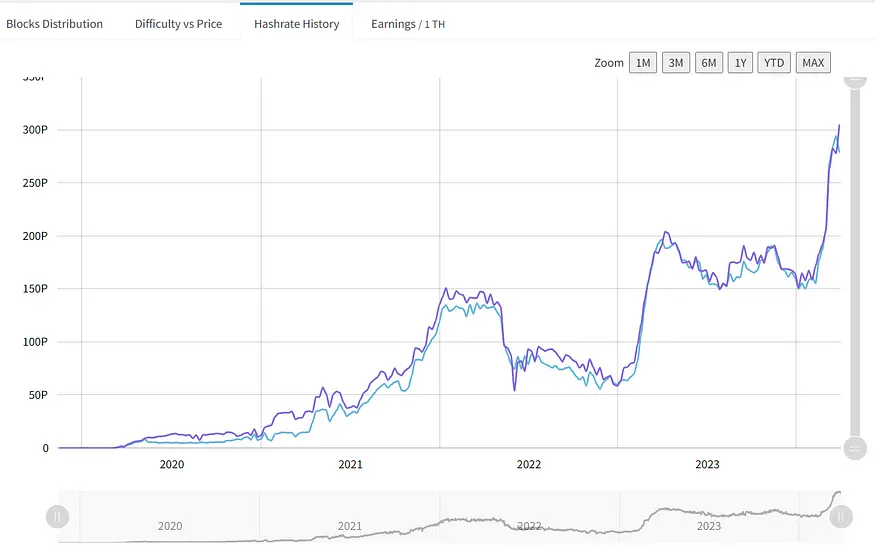
Currently, the mining yield of the CKB token is also good, ranking eighth in mining yield on f2pool.

3.2 Cell Model: Security and Scalability
A Cell is the most basic structure representing a single piece of data in Nervos. The data contained in a Cell can take various forms, including CKByte, tokens, JavaScript code, or even serialized data like JSON strings. Since there are no restrictions on the types of data included, developers have the flexibility to choose.
The Cell model treats all digital assets (such as CKB, tokens, and digital collectibles) as proprietary property and responsibility of their owners. Assets must comply with smart contract rules when participating in transactions, but the assets essentially belong to the user rather than the smart contract. Even the smart contract defining the token does not have authority over the asset. This means that even if an attacker finds a vulnerability in the contract code, they still cannot access the asset because it is under the user's control. This enhances the security of the assets.
On this basis, the Cell model adds programmability, supporting smart contracts. Specifically, the Cell abstracts the nValue field representing token value in UTXO into two fields: capacity and data, where data stores the state and can hold any data. Additionally, the Cell data structure includes two fields, LockScript and TypeScript, where the former mainly reflects ownership, and the latter can be customized with many rich functions.
3.3 RGB++ Protocol: Contract Extension and Performance Increase
RGB++ is an extended protocol based on RGB, utilizing one-time stamps and client validation technology to manage state changes and transaction validation. It maps Bitcoin UTXOs to Nervos CKB Cells through isomorphic binding and uses scripts on CKB and the Bitcoin chain to verify the correctness of state calculations and the validity of ownership changes.
RGB++ addresses the technical challenges faced by the original RGB protocol in practical implementation and provides more possibilities, such as blockchain-enhanced client validation, transaction folding, shared state for non-interactive contracts, and non-interactive transmission.
RGB++ inherits the core ideas of the RGB protocol, adopting different virtual machines and validation schemes. Users do not need a separate RGB++ client; they can complete all validations independently by connecting to Bitcoin and CKB light nodes. RGB++ brings Turing-complete contract extensions and performance improvements to Bitcoin. It does not use any cross-chain bridges but employs a native client validation solution to ensure security and censorship resistance.
3.4 Spore Protocol: Upgraded Ordinals
In mid-March 2024, the Nervos Network ecosystem project JoyID wallet officially launched the first Spore DOB Marketplace based on UTXO order book trading mode, and the first DOB asset—Unicorn Box—has been opened for trading. Unicorn Box is an airdrop for community users, with the claiming period now closed. It occupied 340 CKB during minting, and the current market floor price is 71,800 CKB, a 200-fold increase.
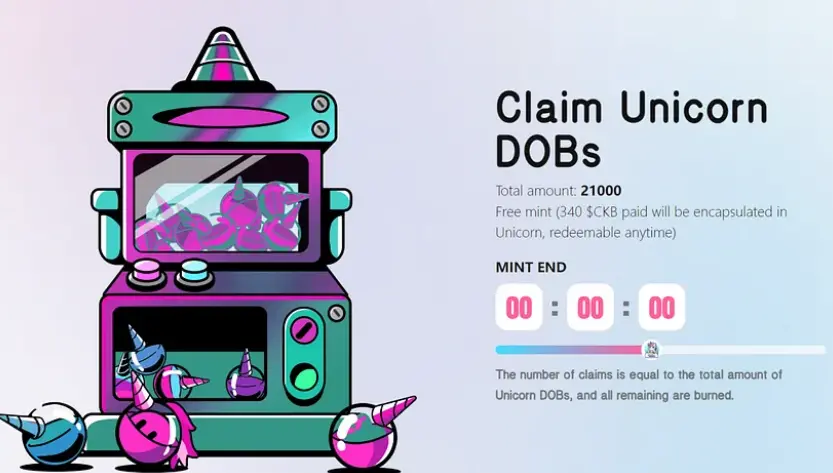
DOB (Digital Object) is a crypto asset issued through the Spore protocol on the CKB blockchain. DOBs generated by the Spore protocol are immutable, fully stored on-chain, and establish an intrinsic connection between content and value.
If CKB is seen as an upgraded version of Bitcoin, then Spore is an upgraded version of Ordinals. Its main features are as follows:
- It supports various content types such as video, audio, and text, giving creators more space.
- Content is fully stored on-chain, making it a complete digital asset. In contrast, previous NFTs only stored link addresses on-chain, with most content stored off-chain.
- Generating a DOB requires obtaining CKB tokens as "raw materials," and the amount of CKB minted determines the size of the DOB's storage space on-chain. Destroying a DOB allows the retrieval of the occupied CKB. This mechanism ensures that holding Spore DOB is equivalent to occupying CKB, thereby reducing the circulation of CKB within the ecosystem.
- No transaction fees. When minting DOBs through the Spore protocol, an additional 1 CKB is automatically deposited. Under non-congested network conditions, 1 CKB is sufficient to cover the miner fees for over 7,000 on-chain transfers, thus achieving a fee-free effect in subsequent transactions. This can enhance user experience and attract new users.
- It can flow freely between different UTXO chains. According to current plans, the RGB++ protocol for issuing layer 1 Bitcoin assets is expected to launch at the end of March or early April, at which point DOBs issued on the CKB blockchain can leap to the Bitcoin mainnet via RGB++, becoming digital objects on the Bitcoin chain.
4. Ecological Development
The Nervos Network ecosystem is taking shape, including projects such as wallets, cross-chain bridges, DID, and DeFi. However, there are not many well-known projects, and no phenomenal products have emerged yet.
As a BTC L2, the main issue is to enhance the application level of BTC, activating its liquidity. In this regard, Nervos Network is still in its early stages.
According to community information, the RGB++ protocol is planned to launch at the end of March or early April, which will bring more gameplay and enrich the ecosystem.
The ecological project Nervape has just released a whitelist snapshot, and its DOBs, set to be released in early April, will also be directly issued on the BTC chain.
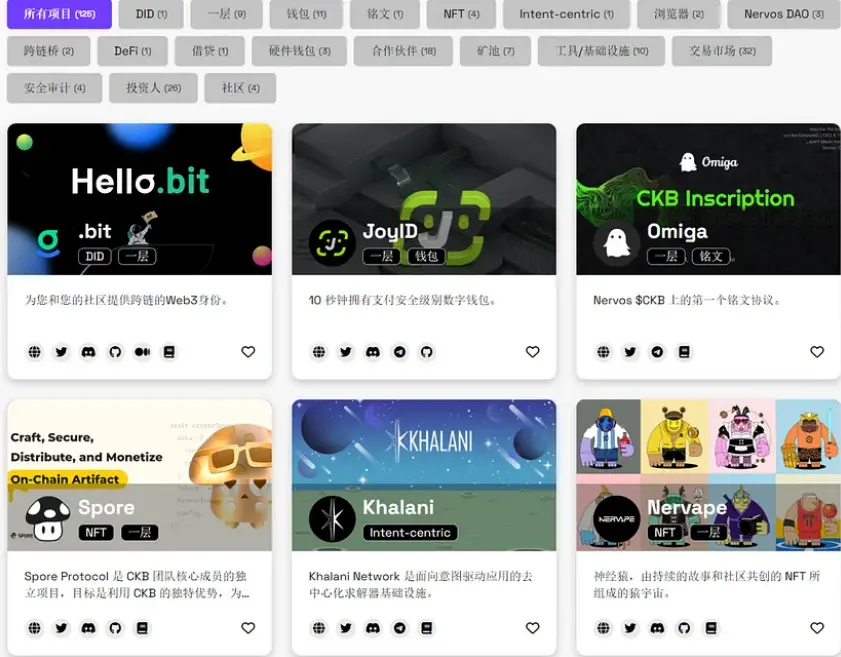
From on-chain data, the number of transactions for the protocol has increased, with a significant amount of interactions occurring in early 2024. The number of independent addresses and Cells continues to grow, and on-chain transaction fee revenue saw an increase at the end of 2023. Overall, on-chain data shows significant growth and increased activity.
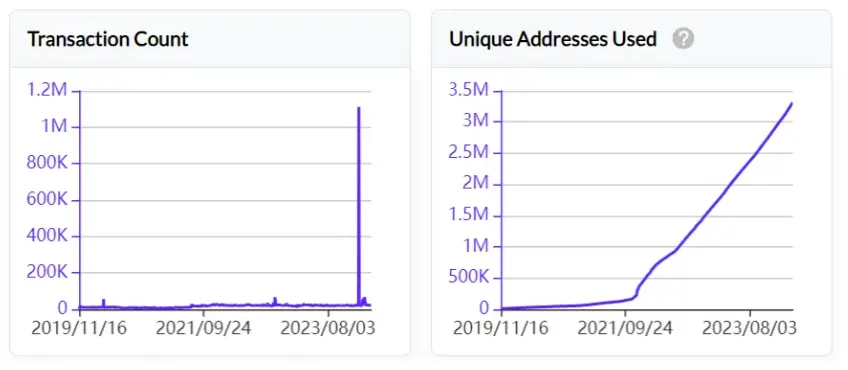
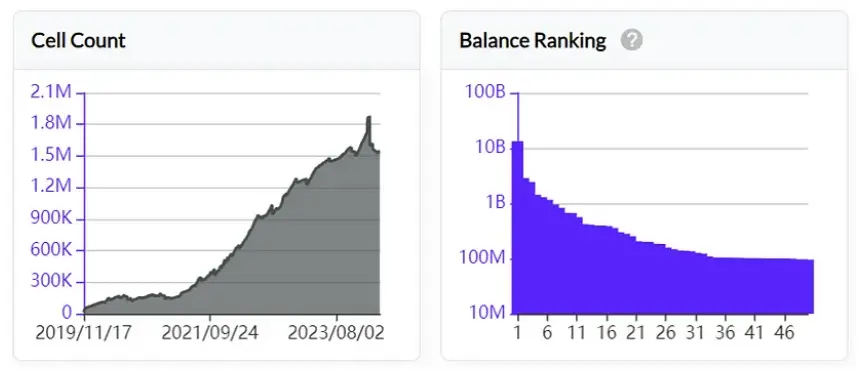

5. Token Economic Model
5.1 Token Distribution and Release
Currently, the total issuance of the CKB token is 44.5 billion, with a circulating supply of 43.8 billion, and 9.4 billion locked in NervosDAO.
The initial supply of CKB tokens was 33.6 billion, of which 8.4 billion have been burned, resulting in an actual supply of 25.2 billion, allocated to investors, the team, and ecological funds, all of which have been unlocked.
CKB is an inflationary token, with inflation coming from two parts:
One is mining inflation, which is entirely used to reward miners. The inflation rate follows BTC, halving every four years until it reaches zero. In the first four years, 4.2 billion were added each year, with the first halving occurring in November 2023, reducing the issuance to 2.1 billion CKB per year. The second halving is expected to occur in November 2027, reducing the issuance to 1.05 billion CKB per year.
The second is a fixed annual issuance of 1.344 billion tokens, also known as "secondary issuance." This portion of tokens will be used for: incentives for miners (state rent for users storing data on-chain); incentives for Nervos DAO depositors (users locking CKB in the DAO); treasury funds (based on liquid CKB not used for data storage), with the portion deposited in the treasury being burned.
The current specific distribution is shown in the chart below, which indicates that there are approximately 5.77 billion CKB tokens in secondary issuance, of which 69.5% have been burned, with about 1.77 billion entering circulation.
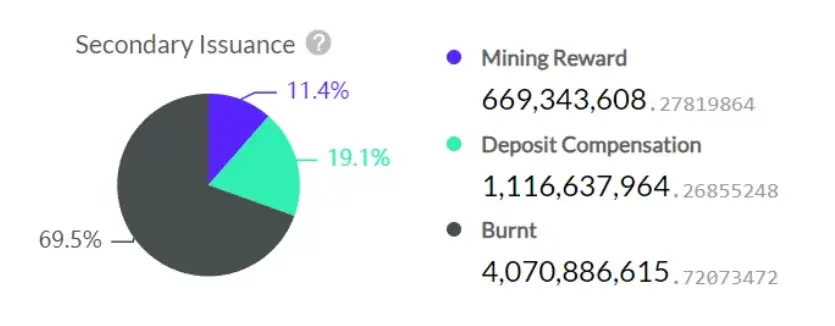
Based on this calculation, in the coming year, CKB will add approximately 2.5 billion new tokens, with an annual inflation rate of about 5.7%, representing a moderate inflation rate.
5.2 NervosDAO Staking
NervosDAO has locked approximately 9.4 billion tokens, accounting for about 21% of the total circulating supply, with an average deposit time of about 800 days, indicating long-term holding. Currently, the staking yield is not high, at only 2.29%, making staking less attractive.

Historically, during the bull market in 2021, the highest locked amount reached about 12 billion, followed by a decline to around 8 billion. Therefore, overall, this portion of holdings is relatively stable. Since the end of 2023, there has been an increase in new staking. However, from the ratio of staking to circulating supply, it is generally on a downward trend. New users and new tokens have not entered staking.

5.3 Holding Distribution
The distribution of CKB token holdings is highly concentrated, with a total of 270,000 addresses holding CKB on-chain, where the top 100 holding addresses own 76.93% of the tokens, and the top 10 addresses hold 54.28%, with Binance's address holding over 32% of the tokens.
Among the top 10 holding addresses, excluding exchange addresses, there are four unmarked addresses. The fourth-largest address was established in May 2023 and has continued to receive transfers, with the latest transfer on March 25, 2024, and has not participated in staking. The fifth-largest address was established in May 2023, with only one transfer in and has not participated in staking. The eighth-largest address was established in 2021, with only one transfer in, and has participated fully in staking. The ninth-largest address was established on March 22, 2024, and has not participated in staking.
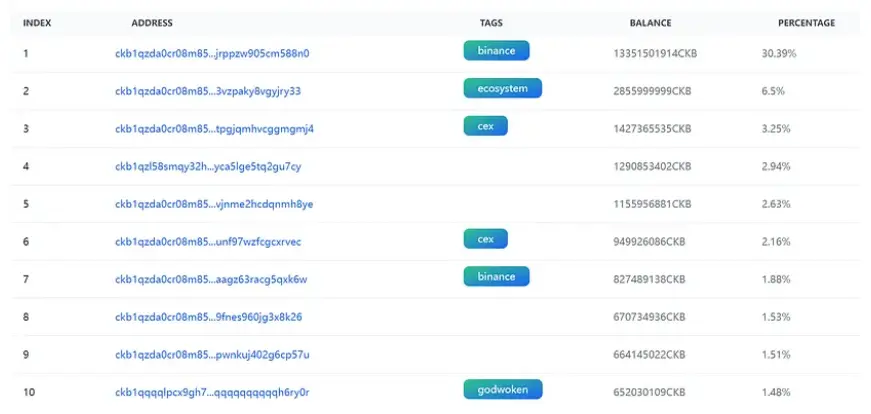
6. Conclusion
Nervos Network is a POW+UTXO isomorphic public chain launched in 2019, currently positioned as BTC L2. The team has considerable development experience, and the product has innovations in programmability and scalability. Since 2024, concepts such as RGB++ and DOB have been introduced, aligning with the current narrative of BTC L2 development.
The ecosystem is taking shape, and community activity is decent. As a BTC L2, the ecological focus should be on bringing more convenient BTC applications and activating the liquidity of BTC assets. The RGB++ protocol is planned to launch at the end of March or early April 2024, and the ecological project Nervape plans to issue DOBs on the BTC chain, hoping to leverage this opportunity to promote the development of assets on the Bitcoin chain.
The CKB token is an inflationary token. The initially issued tokens are now fully circulating, and inflation occurs annually from two sources: one is based on POW inflation, providing rewards to miners; the other is secondary issuance, with a fixed annual release, part of which will be burned when deposited into the treasury. The overall annual inflation rate is approximately 5.7%. Among the top ten user addresses, excluding exchanges, the overall trend is inflow, with new addresses accumulating CKB tokens since 2023, but not entering staking.
Overall, Nervos Network has a solid foundation, and key observations should focus on changes in token staking, progress in ecological development, scale, and market heat.






